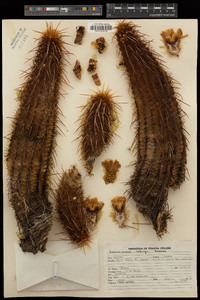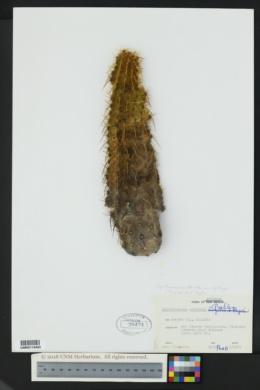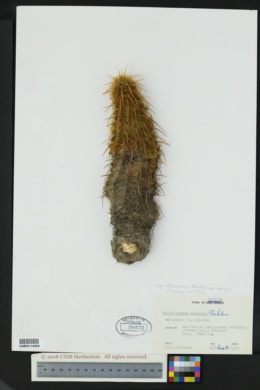

- Home
- Specimen Search
- Images
- Flora Projects
- Agency Floras
- Dynamic Floras
-
Additional Websites
- New Mexico Flores
- Plant Atlas Project of Arizona (PAPAZ)
- Southwest Colorado Wildflowers
- Vascular Plants of the Gila Wilderness
- Consortium of Midwest Herbaria
- Consortium of Southern Rocky Mountain Herbaria
- Intermountain Region Herbaria Network (IRHN)
- Mid-Atlantic Herbaria
- North American Network of Small Herbaria (NANSH)
- Northern Great Plains Herbaria
- Red de Herbarios del Noroeste de México (northern Mexico)
- SERNEC - Southeastern USA
- Texas Oklahoma Regional Consortium of Herbaria (TORCH)
- Resources
|
|
|
|
Family: Cactaceae
Leding hedgehog cactus, more...Leding's Hedgehog Cactus, Leding's hedgehog cactus
[Echinocereus fendleri var. ledingii (Peebles) N.P. Taylor] |
Plants 4-15-branched, forming rather open clumps. Stems erect, cylindric, 15-50 × 6-8 cm; ribs 12-14(-16), crests slightly un-dulate; areoles 15-25 mm apart. Spines 10-16 per areole, mostly straight or central spines strongly curving down near base; radial spines 9-11 per areole, pale to golden yellow, aging darker colored or black, 12-15 mm; central spines 1(-5) per areole, all yellow or whitish, terete, 20-25 mm. Flowers 5-6 × 5-6 cm; flower tube 15-20 × 15-25 mm; flower tube hairs 2 mm; inner tepals magenta to rose-pink, darker proximally, 30 × 5-12 mm, tips relatively thin and delicate; anthers yellow; nectar chamber 5-8 mm. Fruits green, sometimes tinged reddish to brownish, 20-30 mm, pulp white. 2n = 22. Flowering May-Jun; fruiting 3.5 months after flowering. Rocky mountainsides, interior chaparral, oak woodland, igneous substrates; 1200-2000 m; Ariz. More than half of the localities formerly attributed to Echinocereus ledingii (H. Bravo-H. and H. Sánchez-M. 1998-1991, vol. 3; L. D. Benson 1969) are undocumented and highly suspect. The decurved or deflexed central spines, supposedly diagnostic for this rare species, are misleadingly duplicated in many individuals of E. coccineus and E. arizonicus, and only the latter two species have been found in most of the mountain ranges mapped by A. A. Nichol for L. D. Benson. Echinocereus ledingii is found in the Graham (Pinaleño), Santa Theresa, and Chiricahua mountains.
FNA 2003, Benson 1982, ITIS, Kearney and Peebles 1969 Common Name: Leding's hedgehog cactus Duration: Perennial Protected Status: Salvage restriced status in Arizona. General: Open clumps with 4-15 green ovoid to cylindroid but firm and often elongate stems that are erect and 15-50 cm tall by 6-8 cm diameter, with 12-14 ribs that have slightly undulate crests bearing areoles 15-25 mm apart. Spines: Mostly straight and stout (to 1.25 mm diameter) central spines that are strongly curving down near the base with 10-16 per areole, the radial spines have 9-11 per areole and are pale to golden yellow but aging darker colored or black, these 12-15 mm with 1 central spine per areole accompanied by 1-4 short accessory central spines that are all yellow or whitish and terete, 2-25 mm long with the spines tending to cover the stem surface entirely. Flowers: Flower 5-6 cm diameter and long, with flower tube 15-20 mm by 15-25 mm, with hairs 2 mm, inner tepals magenta to rose pink, darker outside, elliptic-cuneate, 30 mm long by 5-12 mm wide, tips thin and delicate, yellow anthers. Fruits: Green, but sometimes tinged reddish to brownish, 20-30 mm. Ecology: Found on rocky, gravelly, and even sandy slopes in grassland, woodland, or chaparral from 4,000-6,500 ft (1219-1981 m), flowers May-June. Notes: Said to be distinguished by the decurved or deflexed central spines, but these are also found in E. coccineus and E. arizonicus, so close attention must be paid. This is worth documenting wherever it is believed to be found as it has an uncertain distribution. Known principally from the Pinalenos, Chiricahuas, and Santa Theresa mountains in southeastern Arizona. Ethnobotany: Unknown Etymology: Echinocereus is from the Greek echinos, hedgehog or spine and cereus, waxy, while ledingii is named for the American botanist J.R. Leding. Synonyms: Echinocereus fendleri var. ledingii Editor: SBuckley, 2010 |

Development supported by National Science Foundation Grants
(DBI 9983132,
BRC 0237418,
DBI 0743827,
DBI 0847966)
Powered by Symbiota
Powered by Symbiota



































